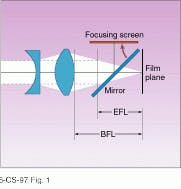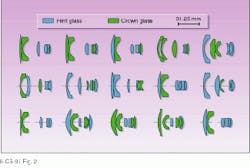Global optimization leads to better designs
Global optimization leads to better designs
Tom Kuper
Although global-optimization algorithms have been available in lens-design programs for some time, many designers remain skeptical. The latest version of CODE V (Optical Research Associates` ORA; Pasadena, CA) contains an enhanced global-optimization routine intended to overcome some of these objections. In particular, this new algorithm runs significantly faster and delivers a wider variety of useful solutions than previous programs.
Until five years ago, virtually all lens-design programs performed only local design optimization. In local optimization, the user presents an approximate, or first-order, design to the algorithm, which improves system performance by making relatively small adjustments to parameters such as lens curvatures, thicknesses, and glass types. The final design is only an optimized version of the starting point, so the quality of the starting point is a major determining factor in the performance of the final design. The design process remains heavily dependent on the knowledge and experience of the individual designer, as well as on the time available to develo¥different starting config-urations. Local optimization does not provide an automatic mechanism for design innovation.
In global optimization, by contrast, the program produces designs that depart significantly from the starting point; the program looks for a global, rather than just a local, minimum in the design-optimization process. A number of different potential design approaches exist for any problem, so the ideal global-optimization routine should find and optimize several of the better designs. Variations can include changes in the distribution of positive and negative elements, significant alterations to the shapes of individual elements, and changes in the types of glasses used. Global optimization thus has the potential to deliver designs that far exceed the performance of even the best optimization of a single starting point.
Too good to be true?
Despite this potential, the attitude of many optical designers toward global optimization has been that it is "too good to be true." In the past, unfortunately, they have frequently been right because of the inherent complexity of the optical-design process.
Many global-optimization algorithms that have been developed and successfully applied in other fields do not adapt well to the types of constraints found in a typical optical-design problem. Some algorithms cannot produce solutions in a reasonable time frame on typically available computational platforms. Thus, the history of global optimization is littered with highly touted techniques that failed to deliver when applied to a challenging design.
Our own experience at ORA reflects this. Our initial encounter with a global-optimization algorithm created by an engineer from another field was very successful when applied to a certain class of relatively straightforward problems, but failed with more complex systems, such as an inverted telephoto design. However, the promise of these initial investigations motivated us to develo¥our own global-optimization routine specifically intended for a very broad range of problems and able to operate successfully even in the presence of numerous linear and nonlinear boundary constraints.
The result of this effort was the introduction of our own global-optimization routine, Global Synthesis, to CODE V in 1992. Global Synthesis has proven successful in supplying novel solutions to a wide range of lens-design problems. Proof of this is found in the results of the 1994 International Optical Design conference design problem. The challenge was to design a minimal-volume, all-spherical-surfaced system capable of imaging 108 Airy disks over a flat field. Designs generated with our global-optimization algorithm placed first and second in the competition. No other design from a program using a global optimizer even placed in the to䂈 of this competition. Furthermore, even when complexity was controlled by limiting the number of allowed lens elements, Global Synthesis still produced designs that matched or exceeded the performance of all comparably complex lenses submitted for the competition.
Recently, we have focused our development efforts on improving the two most important characteristics of a global optimizer--speed and the ability to generate numerous useful, distinct alternate solutions from a given initial design. The latter factor directly influences the ability of the software to produce useful designs independent of the starting-point configuration.
The new algorithm, first included in CODE V 8.11, finds solutions an average of five times faster than the previous version. Although it uses the same basic approach, the streamlined and restructured computational process eliminates unnecessary and redundant calculations. Because the new algorithm works faster, it can search a greater volume of solution space in a given amount of time, discovering a larger number of distinct forms. Typically, the new algorithm generates more than twice as many unique solutions to a design problem over an average run time than previously.
Case study: inverted telephoto lens
The power to generate multiple, distinct solutions is best illustrated by the example of an inverted telephoto lens. In its simplest form, the inverted telephoto consists of a front lens grou¥with negative focal length and a back lens grou¥with positive focal length. This arrangement yields a lens with back focal length that is longer than the effective focal length (see Fig. 1). Such designs are common in short-focal-length (35 mm and shorter), wide-angle lenses for single-lens reflex cameras, which require adequate space behind the lens for the movement of the camera viewing-system mirror.
The inverted telephoto design is particularly challenging because it is difficult to simultaneously achieve acceptable image quality, distortion, and relative illumination while maintaining package-size constraints. In this particular design experiment, the starting point was a locally optimized version of an existing 28-mm inverted telephoto lens design patented in July 1978 by Nikon. A total of 36 system variables and 20 constraints (including back focal length, overall length, front element size, minimum and maximum element center and edge thicknesses, and distortion) were specified.
The software generated a variety of solutions (see Fig. 2). Not only did the software find an optimized, superior version of the original patented lens design, it developed two other designs with even better performance, one of which is more easily manufacturable than the patented lens. Global optimization allows the lens designer to explore a larger region of potential "design space" in a given time than local-optimization routines. Moreover, the global approach has less-stringent requirements on the quality of the starting design. o
FIGURE 1. Inverted telephoto design uses a front lens grou¥with negative focal length and a back lens grou¥with positive focal length to achieve a system with a smaller effective focal length (EFL) than back focal length (BFL). This provides space for the camera`s mirror to swing out of the way during exposure.
FIGURE 2. Global-optimization software developed 15 alternatives to a patented telephoto lens. Note that similar-looking designs may use entirely different glass types.


